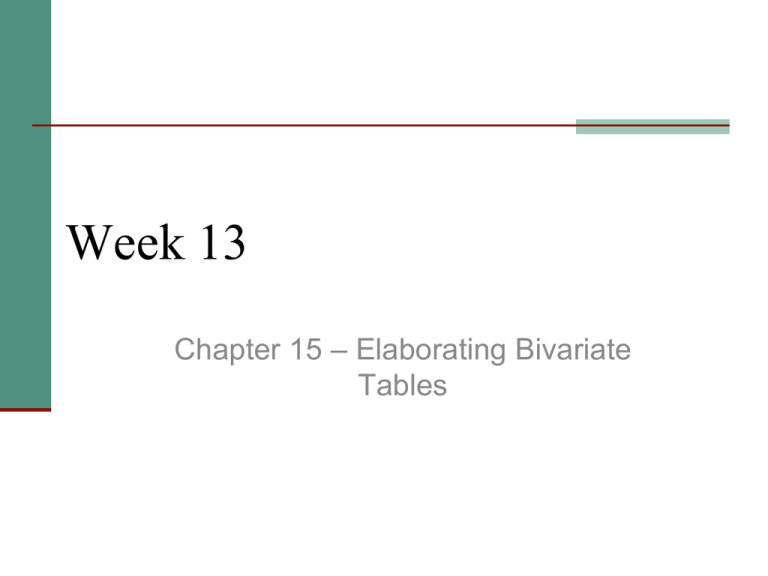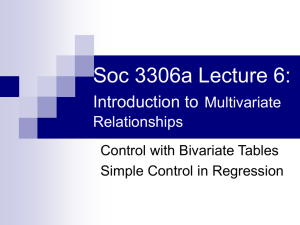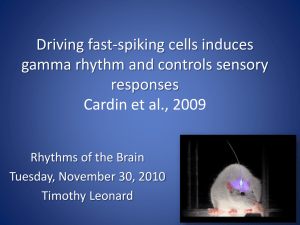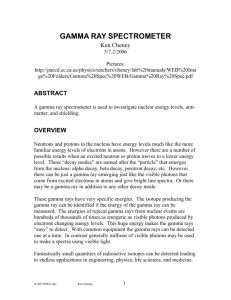
Week 13
Chapter 15 – Elaborating Bivariate
Tables
Chapter 15
Elaborating Bivariate Tables
In This Presentation
The logic of the elaboration technique.
The construction and interpretation of partial
tables.
The interpretation of partial measures of
association.
Direct, spurious, intervening, and interactive
relationships.
Partial Gamma
Limitations of elaboration
Key role of theory
Controlling for a Third Variable
Three criteria must be met to determine
causation:
Time order
Correlation
Non-Spuriousness
This is determined by controlling for a third
variable (Z)
Controlling for a Third Variable
To “elaborate”, we observe how a control
variable (Z) affects the relationship between
X and Y
To control for a third variable, the bivariate
relationship is reconstructed for each value of
the control variable
Tables that display the relationship between
X and Y for each value of Z (a third variable)
are called partial tables (Stacked Tables)
Controlling for a Third Variable
Focus on Three Basic Patterns
Direct relationships
Spurious or Intervening relationships
Interaction
Controlling for a Third Variable
Direct Relationships
In a direct relationship, the control variable has little
effect on the relationship between X and Y
The column percentages and Gammas in the partial
tables are about the same as the bivariate table
(Original table)
This outcome supports the argument that X causes Y
Also referred to as replication
Controlling for a Third Variable
Spurious Relationships
In a spurious relationship X and Y are not related,
both are caused by Z
In a spurious relationship the Gammas in the partial
tables are dramatically lower than the gamma in the
bivariate table, perhaps even falling to zero
Also referred to as explanation
X
Z
Y
Controlling for a Third Variable
Intervening Relationships
In an intervening relationship X and Y are not directly
related to each other but are linked by Z, which
“intervenes” between the two
Also referred to as interpretation
Z
X
Y
Controlling for a Third Variable
Interaction
Interaction occurs when the relationship between X
and Y changes across the categories of Z
X and Y could only be related for some categories of
Z
X and Y could have a positive relationship for one
category of Z and a negative one for others
Z1
X
Y
Z2
0
Z1
+
X
Y
Z2
-
Controlling for a Third Variable
Summary
Partial Gamma
Partial Gamma indicates the overall strength of
association between X and Y after the effects of the
control variable, Z, have been removed
Compare Partial Gamma to the Gamma for the
bivariate table to see if the relationship has changed
Example 1
The table below summarizes the relationship between Number
of Memberships in Student Organizations (X, independent
variable) and Satisfaction with College (Y, dependent variable)
Example 1
Comparing the conditional distributions of Y (the column
percentages), we find a positive relationship; this direction is
confirmed by the sign of Gamma (G = +0.40), which is
positive as well
College students with at least one membership in a student
organization are more likely than students with no
memberships to rate their satisfaction as high
Example 1
The tables below introduce the control variable, GPA
Example 1
Looking first at the table for students with high GPAs,
we continue to find a positive relationship (G = +0.40)
Example 1
Looking next at the table for students with high GPAs,
we also find a positive relationship (G = +0.39)
Example 1
The relationship between integration and satisfaction is the
same in the partial tables as it was in the bivariate table
Therefore, we have evidence of a direct relationship
Example 1
This conclusion is further supported by the
calculation of Partial Gamma (Gp = +0.40), which
is the same as the bivariate value
Example 2
The tables below introduce a new control variable, class
standing
Example 2
Looking first at the table for Upperclass
students, we find no relationship (G =
+0.01)
Example 2
Looking next at the table for Underclass
students, we also find no relationship (G =
+0.01)
Example 2
The original bivariate relationship between memberships and
satisfaction disappears in the partial tables
When the relationship disappears, we have either a spurious or
an intervening relationship
Example 2
We base the decision on which
(spurious or intervening) on
temporal (timing) or theoretical
grounds
In this case, a spurious
relationship makes more sense
because class standing (being
an Upper- or Underclass
student) likely predicts the
number of memberships, and
not the other way around
The Partial Gamma also
supports our conclusion; it too
was reduced to zero
Example 3
The tables below introduce a third control variable, race
Example 3
Looking first at the table for White students, we find a
strong, positive relationship (G = +0.67)
Example 3
Looking next at the table for Black students, we find a
moderate, negative relationship (G = -0.31)
Example 3
The relationship between memberships and satisfaction differs across
categories of the control variable
For one partial table, the relationship is positive
For the other partial table, the relationship is negative
Therefore, we have evidence of interaction
Example 4
The table below summarizes the relationship between Length of
Residency and English Facility for a sample of 50 immigrants
(problem 15.1, p. 425)
The independent variable (X) is length of residence, and the
dependent variable (Y) is facility with English
Gamma = +0.67, which indicates a strong, positive relationship
between the variables; as length of residence increases, facility
with English also increases
Example 4
We have introduced sex as a control variable in the tables below
Example 4
The Gamma for males is 0.78
The Gamma for females is 0.65
The Partial Gamma is 0.71
G males
Ns Nd
Ns Nd
G f emales
G partial
Ns Nd
Ns Nd
N
N
s
s
80 10
80 10
70 15
70 15
N
N
0 . 78
d
d
0 . 65
( 80 70 ) (10 15 )
( 80 70 ) (10 15 )
0 . 71
Example 4
While the two Gammas for the partial tables (0.78
and 0.65) differ slightly, they both indicate a strong,
positive relationship between length of residence and
English facility
Comparing Partial Gamma (0.71) to the original
Gamma (0.67), we find little difference
Therefore, we have evidence of a direct
relationship
Controlling for sex does not affect the relationship
between length of residence and English facility for
immigrants
Example 5
The table below summarizes the relationship
between Academic Record (X) and Delinquency (Y)
for a sample of 78 juvenile males
Comparing the column percentages and examining
the sign of Gamma (-0.69), we conclude that juvenile
males with better academic records have lower
delinquency
Example 5
We next control for area of residence
Example 5
The Gamma for the “Urban Areas” table is -0.05,
indicating no relationship between academic record
and delinquency
The Gamma for the “Nonurban Areas” table is -0.89,
indicating a strong, negative relationship between
academic record and delinquency
The relationships between X and Y differ across our
partial tables
Therefore, we have interaction
Where Do Control Variables Come
From?
Understanding whether elaboration results in a spurious
relationship (explanation) or an intervening relationship
(interpretation) cannot be based on statistical grounds or
inspecting the partial tables
Control variables are based on theory
Research projects are anchored in theory so control
variables come mainly from theory
“Control variables that might be appropriate to incorporate
in the data-analysis phase will be suggested or implied in
the theoretical backdrop of the research project, along with
the researcher’s imagination and sensitivity to the problem
being addressed.” (p. 420)
Limitations of Elaboration
Basic limitation: Sample size
Greater the number of partial tables, the more
likely to run out of cells or have small cells
Potential solutions
Reduce number of cells by collapsing
categories (recoding)
2. Use very large samples
3. Use techniques appropriate for interval-ratio
level (see Chapter 16)
1.












